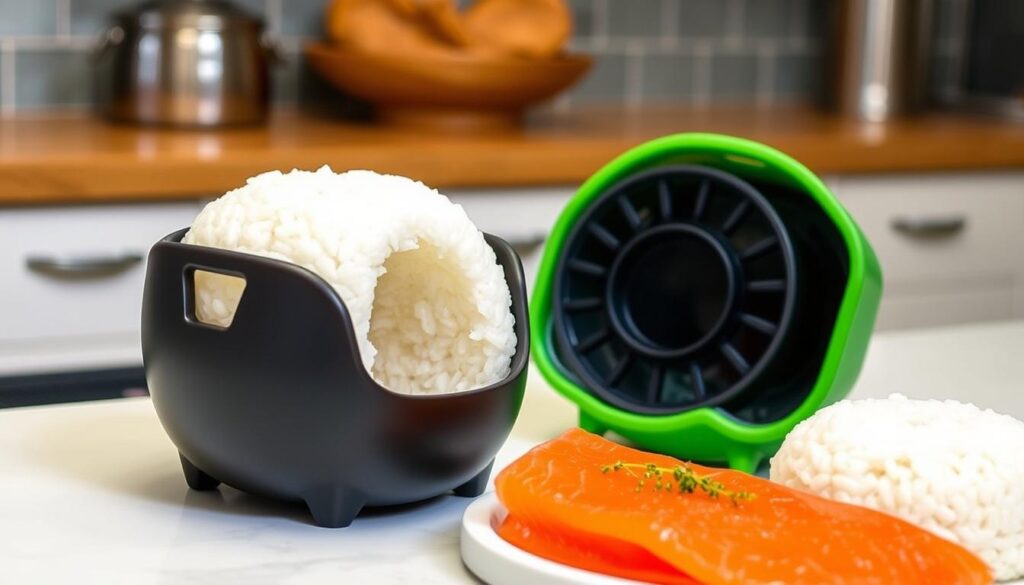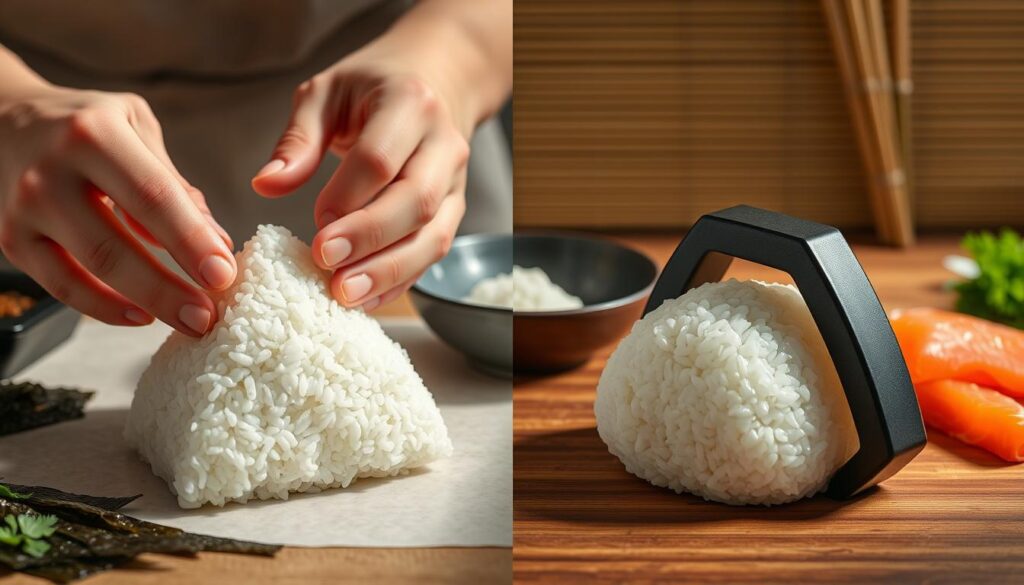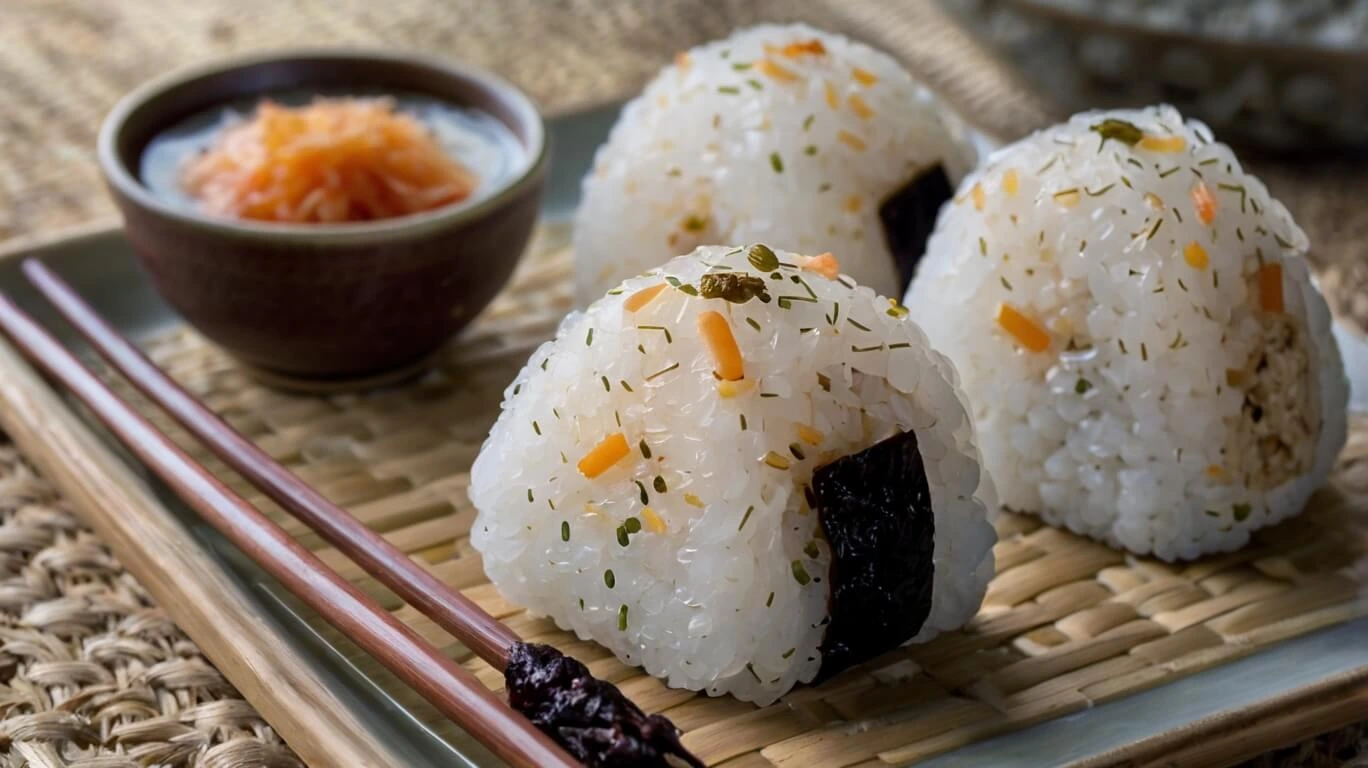Salmon onigiri, also known as Japanese rice balls, are a delightful and versatile snack. You can easily make them at home. They feature a savory salmon filling that perfectly complements the warm, sticky rice.
Whether you’re looking to use up leftover salmon or want to try a traditional Japanese dish, this salmon onigiri recipe is perfect. It’s a fantastic option for you.
Salmon onigiri are a popular Japanese comfort food. They can be enjoyed for lunch, a light dinner, or as a satisfying snack. The combination of tender salmon, fragrant rice, and the optional crispy exterior makes for a delightful experience.
Best of all, this recipe is easy to prepare. You can also customize it to your taste preferences.
Table of Contents
Introduction to Traditional Japanese Rice Balls
Onigiri, the beloved traditional Japanese rice snack, have been a staple in the country’s cuisine for centuries. These bite-sized rice balls are often considered the “sandwiches” of Japanese food culture. They serve as comforting and portable sustenance. Onigiri are a common sight in school lunches, convenience stores, and as travel snacks, making them an integral part of everyday Japanese life.
Cultural Significance of Onigiri in Japan
The significance of onigiri in Japanese culture extends far beyond their delicious taste. These traditional Japanese rice balls hold deep cultural and sentimental value. Onigiri are often associated with the concept of mottainai, which emphasizes the importance of not wasting resources. The compact, hand-held nature of onigiri reflects the Japanese appreciation for minimalism and efficiency.
Why Salmon Onigiri Became Popular
Among the many fillings found in onigiri, salted salmon (known as shake) has become a beloved classic. The popularity of salmon onigiri can be attributed to the widespread availability of high-quality salmon in Japan. Its delightful flavor and nutritional benefits also play a role. Salmon’s versatility as a filling, combined with its status as a beloved Japanese ingredient, has solidified its place as a quintessential onigiri offering.
Essential Ingredients for Perfect Salmon Onigiri
Making delicious salmon onigiri, the beloved Japanese rice balls, needs a few key ingredients. The base is short-grain Japanese rice. It gives the rice balls the right texture and shape. Cooked salmon, whether leftover or canned, adds a savory seafood flavor.
You’ll also need nori (seaweed sheets) to wrap the rice balls. Seasonings like soy sauce, mirin, and rice vinegar boost the flavors. Optional ingredients like Kewpie mayo, sriracha sauce, and furikake can add unique tastes.
The rice’s quality is key for the onigiri’s shape and texture. Short-grain Japanese rice, when cooked right, becomes sticky and easy to shape into perfect rice balls.
- Short-grain Japanese rice
- Cooked salmon (leftover or canned)
- Nori (seaweed sheets)
- Soy sauce
- Mirin (Japanese rice wine)
- Rice vinegar
- Optional: Kewpie mayo, sriracha sauce, furikake
With these ingredients, you’ll be ready to make tasty salmon onigiri. They’ll capture the authentic flavors of traditional Japanese cuisine.
Kitchen Tools and Equipment Needed
Making delicious onigiri, or Japanese rice balls, needs a few key tools. First, you’ll need a good rice cooker or pot for the rice. A big mixing bowl is also important for mixing the rice with seasonings or fillings.
Traditional vs. Modern Onigiri Making Tools
Traditionally, people used their hands to shape onigiri. They used damp fingers to make the rice into triangles or balls. This way, you can add a personal touch. But, many people now use onigiri molds for easier and more uniform shapes.
Rice Cooking Equipment
It’s important to cook the rice right – slightly sticky but fluffy. You can use a rice cooker or a pot on the stovetop. Some like using an Instant Pot or a traditional donabe (clay pot) for the best results.
Shaping and Molding Options
You’ll also need tools for shaping the rice. You can use your hands, an onigiri mold, or plastic wrap. A rice paddle or spoon helps move the warm rice to your chosen shape.
| Essential Onigiri-Making Tools | Recommended Specifications |
|---|---|
| Rice Cooker or Pot | For cooking short-grain Japanese rice to the perfect texture |
| Mixing Bowl | Large enough to accommodate the cooked rice and any fillings |
| Onigiri Mold | Silicone or plastic molds for easy, uniform shaping |
| Rice Paddle or Spoon | For transferring the warm rice to your shaping method |
| Plastic Wrap or Small Bowl | To assist in shaping the rice by hand |

Preparing the Perfect Sushi Rice Base
To make traditional Japanese onigiri, you need a great sushi rice base. The secret to sushi rice preparation is the Japanese rice cooking method. Start by cooking short-grain Japanese rice as the package says, using the right water ratio.
After cooking, season the rice with rice vinegar and mirin. This mix makes the rice sweeter and adds a hint of acidity. Mix the seasoning gently into the warm rice, keeping it soft and fluffy.
- Cook short-grain Japanese rice following package instructions.
- Season the warm, cooked rice with a mixture of rice vinegar and mirin.
- Fold the seasoning into the rice, being gentle to preserve the texture.
- Allow the seasoned rice to cool slightly before shaping the onigiri.
Seasoning the rice right is key to a perfect sushi rice base. By using this Japanese rice cooking method, your onigiri will taste authentic and have the right texture.
| Ingredient | Quantity |
|---|---|
| Short-grain Japanese rice | 1 cup |
| Rice vinegar | 2 tablespoons |
| Mirin | 1 tablespoon |
Salmon Onigiri Recipe: Step-by-Step Guide
Try this easy and tasty salmon onigiri recipe to upgrade your snacks. Onigiri, or Japanese rice balls, are loved worldwide. Here’s how to make the best onigiri filling and shape them perfectly.
Preparing the Salmon Filling
Begin by flaking 4 oz of fresh salmon. Mix it with 1 ½ teaspoons of toasted sesame oil, 1 ½ teaspoons of soy sauce, and ½ teaspoon of toasted white sesame seeds. This makes a tasty salmon filling.
Shaping Techniques
Start with cooked sushi rice. Divide it into 10 parts and shape each into a triangle or oval. Make a small well in the center and fill it with the salmon mixture. Close the rice to seal the filling inside.
Adding Nori Wrapper
Wrap each rice ball with nori (dried seaweed) for a classic look. Brush the rice with sesame oil for a crispy exterior when pan-frying.
Follow these steps to make a delicious salmon onigiri recipe. These snacks are great for a quick meal, lunch, or party appetizer. Try different fillings and toppings to make them your own!
Two Methods of Shaping: Hand vs Mold Technique
When making onigiri, or Japanese rice balls, you have two main ways to shape them. You can either use your hands or an onigiri mold. Both methods make tasty and pretty onigiri, each with its own benefits.
Hand-Shaped Onigiri
The traditional way is to shape onigiri by hand. First, wet your palms to stop the rice from sticking. Then, shape the rice into a triangle or oval. Use your fingers to make it perfect.
This method lets you control the shape and size. You can make onigiri any way you like.
Onigiri Mold Technique
If you want onigiri to look the same, use a mold. Fill the mold with rice, add fillings, and more rice on top. Press down to make it firm.
Your onigiri will come out looking great, ready to be wrapped in seaweed.
Both hand-shaping and using a mold work well for making onigiri. Hand-shaping gives you control, while molds make onigiri look the same. Choose based on what you like and want your onigiri to look like.

Flavor Variations and Additional Toppings
Onigiri, the beloved Japanese rice balls, are known for their versatility. They can be made in many flavors and with different toppings. Let’s explore the endless possibilities of onigiri!
Traditional Seasonings
Discover the rich traditions of Japanese cuisine with onigiri. Try using umeboshi (pickled plum), katsuobushi (dried bonito flakes), and kombu (kelp). These ingredients add a unique savory-sweet taste to the rice balls.
Modern Fusion Options
Want to try something new? Onigiri can be turned into a global fusion snack. Try fillings like teriyaki chicken, tuna mayo, or even tofu or vegetables. Add a spicy mayo drizzle or some sesame seeds for extra flavor and texture.
| Onigiri Filling | Price Range |
|---|---|
| Tuna Mayo | ¥100 – ¥200 |
| Grilled Salmon Flakes | ¥100 – ¥200 |
| Pickled Plum | ¥100 – ¥200 |
| Salted Cod Roe | ¥100 – ¥200 |
| Seasoned Cod Roe (Spiciest) | ¥100 – ¥200 |
Discover the world of onigiri variations and onigiri toppings. Find your new favorite fusion onigiri flavors. Whether you like the traditional or the modern, there’s always something new to try with these Japanese rice balls.
Storage Tips and Make-Ahead Options
Fresh onigiri are best eaten within a few hours. But, with the right storage, you can keep them tasty for up to two days. Wrap each onigiri in plastic wrap and chill it. For extra moisture, wrap them in a thick towel first.
To warm up stored onigiri, microwave them for 30 seconds. Freezing is not recommended as it can ruin the rice’s quality.
Onigiri are great for meal prep. You can make a big batch on the weekend and enjoy them all week. Just keep them stored right to keep them fresh and tasty.
| Storage Method | Shelf Life |
|---|---|
| Wrapped in plastic, refrigerated | Up to 2 days |
| Wrapped in plastic, then in a kitchen towel, refrigerated | Up to 2 days |
| Frozen | Not recommended |
With these easy onigiri storage tips, you can enjoy make-ahead onigiri without losing their fresh, tasty flavor.
Conclusion
Salmon onigiri is a tasty and healthy Japanese rice snack. It brings a taste of Japan right to your home. You can make these rice balls at home and enjoy a nutritious meal or snack anytime.
Onigiri is loved worldwide for its taste, health benefits, and ease. With our simple salmon and rice recipe, you can make delicious salmon onigiri. Try different fillings and toppings to find your favorite and impress others with your cooking.
Perfect salmon onigiri starts with good sushi rice, quality ingredients, and shaping skills. With practice, you’ll make onigiri as good as in a restaurant. Enjoy your homemade salmon onigiri and the mix of rice, salmon, and umami flavors.

